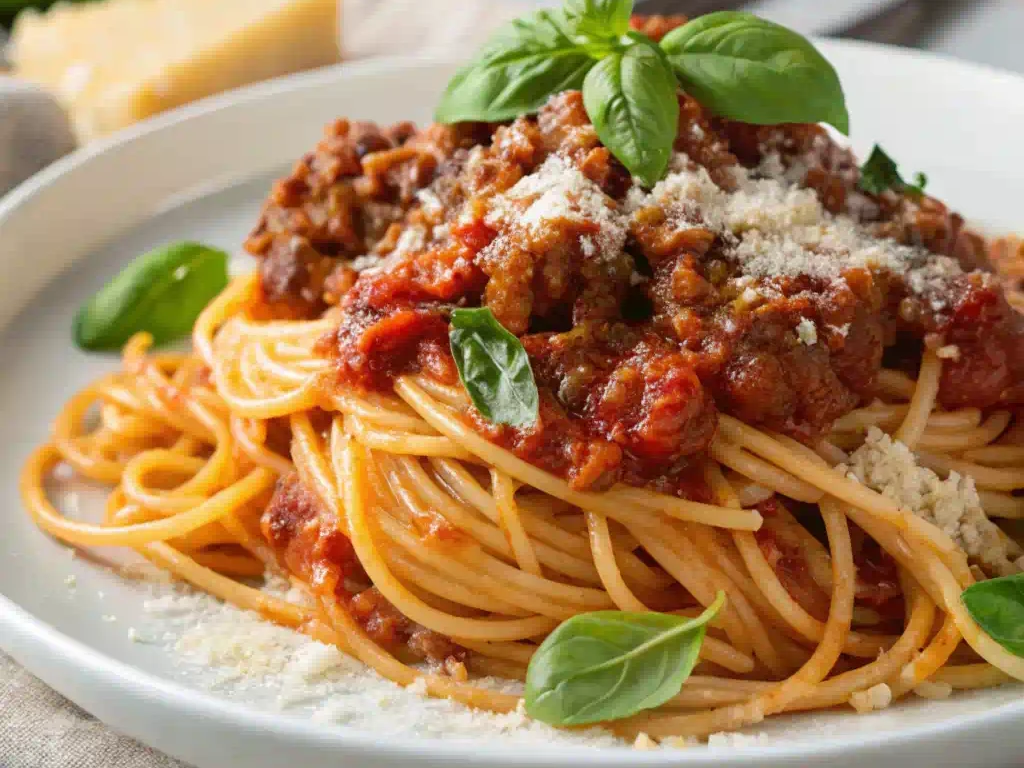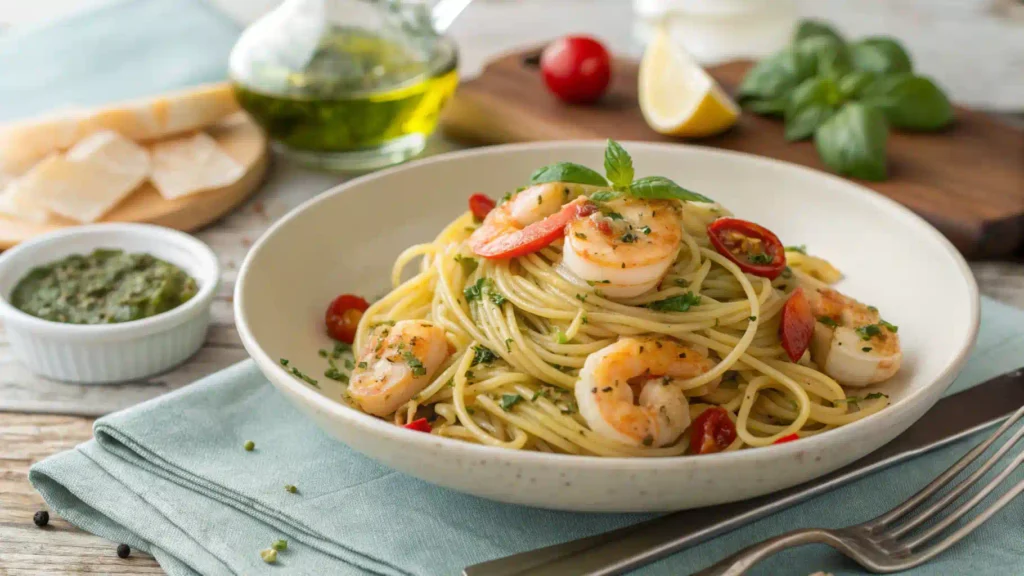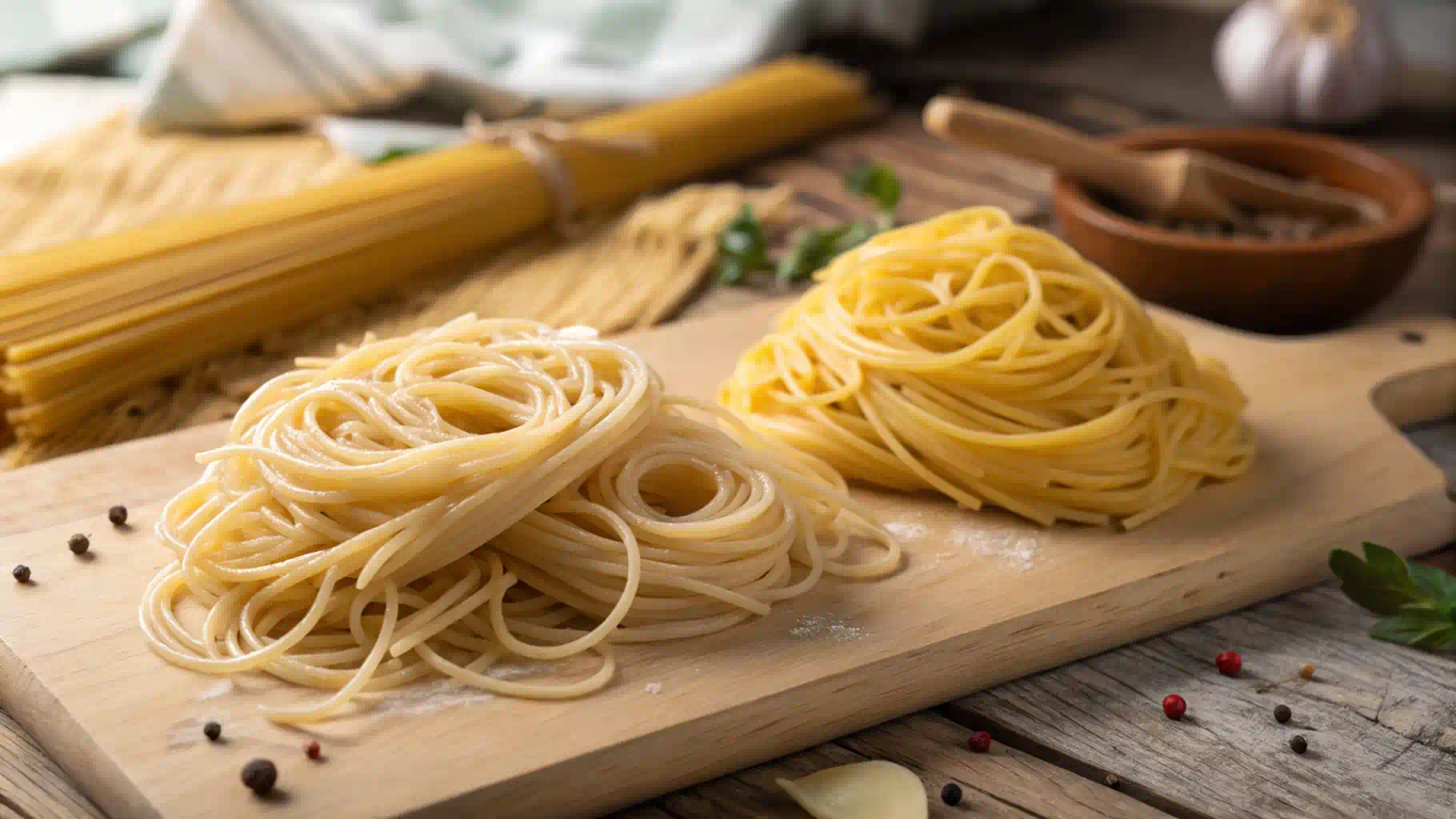If you’ve ever wandered down the pasta aisle, you’ve probably seen spaghetti and spaghettini sitting next to each other on the shelf. They look so similar, but what exactly sets them apart? Are they just two names for the same thing, or is there more to it?
Understanding the difference between spaghetti and spaghettini can actually make a huge impact on the quality of your pasta dishes. Whether you’re cooking a traditional spaghetti Bolognese or whipping up something lighter, choosing the right type of pasta can elevate your meal. So, let’s dive into what makes these two Italian favorites unique. Get ready for some pasta knowledge that might just change the way you cook forever!
Table of contents
- Why Understanding Pasta Types Matters
- A Brief Overview of Spaghetti and Spaghettini
- Defining Spaghetti and Spaghettini
- Key Differences Between Spaghetti and Spaghettini
- Common Uses in Cooking
- Flavor Pairings
- Nutritional Comparison
- Most Common Problems While Cooking Spaghetti or Spaghettini
- Solutions for Perfect Pasta Every Time
- Substituting Spaghetti and Spaghettini
- Exploring More Recipe Inspirations
- Conclusion
Why Understanding Pasta Types Matters
Here’s the thing: pasta isn’t just pasta. Depending on the type, pasta can alter the entire eating experience. Think about it—spaghetti is a bit thicker and chewier, while spaghettini is delicate and light. Using the wrong type in a dish might not ruin the meal, but it definitely won’t have the same texture and flavor harmony you were hoping for. And let’s face it—who doesn’t want their food to be just right?
Let’s break it down. Spaghetti and spaghettini, though both part of the same family, have distinct characteristics that make them suited for different recipes. So, the next time you grab a package of pasta, you’ll know exactly which one to go for. 💡
A Brief Overview of Spaghetti and Spaghettini
Before we get into the specifics, it’s helpful to know what we’re working with. Spaghetti and spaghettini are both long, thin pasta varieties originating from Italy, and they share a common history. The only difference is in their size and thickness. But there’s more to it than just that!
- Spaghetti is the thicker of the two, traditionally used for heavier sauces like marinara, Bolognese, or meatballs.
- Spaghettini, on the other hand, is thinner, lighter, and more delicate. It pairs perfectly with lighter sauces, like seafood or simple olive oil-based dishes.
At first glance, they might look the same, but these subtle differences can change how the pasta holds sauce, how quickly it cooks, and even how filling it feels when you eat it.

Defining Spaghetti and Spaghettini
What Is Spaghetti?
Let’s start with the classic—spaghetti. If you’ve ever eaten pasta, chances are spaghetti was part of your childhood. It’s probably the most recognizable pasta shape in the world. Spaghetti is cylindrical, long, and often found in dishes with hearty sauces. But what exactly makes it spaghetti?
Spaghetti, which literally means “little strings” in Italian, is made from durum wheat semolina and water. This combination results in a dense, chewy texture when cooked, which makes it perfect for thick sauces. It’s also versatile—whether you’re making a quick weeknight dinner or an elaborate meal, spaghetti has your back.
Some of the most popular dishes that use spaghetti include:
- Spaghetti Bolognese 🍝
- Spaghetti Aglio e Olio (garlic and olive oil) 🧄
- Spaghetti with meatballs 🍽️
The key characteristic of spaghetti is its thickness. While the exact measurements can vary, spaghetti typically has a diameter of around 2 millimeters. This allows it to hold onto sauces well, creating a satisfying bite with each forkful.
What Is Spaghettini?
Now, let’s talk about spaghettini. At first glance, you might think it’s just a thinner version of spaghetti. And that’s essentially true—but there’s more to spaghettini than meets the eye.
Spaghettini, which means “little thin strands” in Italian, is made from the same durum wheat semolina as spaghetti, but the dough is rolled thinner. This gives it a delicate, light texture that cooks much faster than spaghetti. Spaghettini is often used in dishes where the pasta is meant to be lighter and more subtle in flavor.
Common recipes that use spaghettini include:
- Spaghettini with garlic, oil, and chili flakes 🌶️
- Spaghettini with seafood 🦞
- Spaghettini with pesto 🍃
Since spaghettini is so much thinner, it’s ideal for light, fresh sauces that won’t overwhelm the delicate strands. It’s also perfect for dishes where the pasta needs to be the star without competing with heavy ingredients. In fact, spaghettini is often the preferred pasta in Italian coastal regions, where lighter, more refreshing dishes are common.

Key Differences Between Spaghetti and Spaghettini
Now that we’ve covered the basics of both pasta types, let’s break down what really sets them apart. It’s all about the thickness, cooking time, texture, and sauce pairing. Let’s dive into each of these differences in more detail.
Thickness and Size Comparison
The most obvious difference between spaghetti and spaghettini is their size. Spaghetti has a thicker, more substantial diameter (around 2 millimeters), while spaghettini is much finer, typically measuring around 1.5 millimeters. It’s the same shape, just a whole lot thinner.
But why does this matter? The thickness affects how the pasta holds sauces and how it feels in your mouth. Spaghetti is hearty and has a satisfying chew, making it perfect for rich, heavy sauces. On the other hand, spaghettini’s delicate nature makes it ideal for lighter sauces, as it won’t overpower the other flavors.
Cooking Times: Which Cooks Faster?
If you’re in a rush, spaghettini is your best friend. Because it’s thinner, it cooks much faster than spaghetti. While spaghetti generally takes about 8 to 12 minutes to cook, spaghettini usually takes only 4 to 7 minutes. This makes spaghettini a great choice for quick weeknight meals.
Here’s a simple rule: The thinner the pasta, the faster it cooks. So, if you’re short on time, spaghettini will get you to the dinner table faster without sacrificing taste.
Texture and Mouthfeel Differences
One of the most noticeable differences between spaghetti and spaghettini is the texture. Spaghetti’s thicker strands offer a chewy, satisfying bite, while spaghettini has a light, almost melt-in-your-mouth quality. The thinner texture means spaghettini doesn’t have that same substantial chew, making it feel more delicate and refined.
This texture difference is particularly important when you’re pairing pasta with sauce. Heavier, meaty sauces cling beautifully to the thicker spaghetti, while the light and airy spaghettini is best suited to oils, broths, or simple butter-based sauces that won’t weigh it down.
Common Uses in Cooking
When it comes to choosing between spaghetti and spaghettini, understanding the dishes they shine in will help you decide which one is best for your meal. Let’s explore the typical dishes where each pasta really stands out and why they’re the perfect match.
Popular Dishes Using Spaghetti
Spaghetti is probably the most well-known pasta in the world, and it plays a starring role in many beloved dishes. Due to its thicker texture, it can hold up well against rich, hearty sauces, making it ideal for a variety of traditional Italian meals. Here are some of the classic dishes where spaghetti is often used:
- Spaghetti Bolognese: A hearty meat sauce made with ground beef, tomatoes, onions, and a mix of herbs. Spaghetti’s thickness makes it perfect for holding onto the rich, savory sauce.
- Spaghetti with Meatballs: Thick, tender meatballs in a flavorful tomato sauce. The dense texture of spaghetti holds up to the weight of the meatballs and sauce.
- Spaghetti Carbonara: A creamy sauce made from eggs, cheese, pancetta, and pepper. The chewy texture of spaghetti allows it to soak up the creamy sauce, making each bite rich and satisfying.
Spaghetti is perfect for hearty dishes where the pasta needs to stand up to bold, flavorful sauces. It’s the ideal choice when you want something that can support the sauce without getting overwhelmed.

Recipes Where Spaghettini Shines
Spaghettini, being thinner and more delicate, is better suited for lighter, more subtle sauces. It pairs wonderfully with dishes that highlight the freshness of the ingredients. Here are some dishes where spaghettini is the star:
- Spaghettini with Garlic and Olive Oil (Aglio e Olio): A simple yet delicious dish with olive oil, garlic, chili flakes, and parsley. The light spaghettini allows the flavor of the garlic and oil to shine through without being too heavy.
- Spaghettini with Seafood: Light seafood pasta dishes, such as those with shrimp or clams, are perfect for spaghettini. The delicate pasta won’t overpower the seafood, letting the freshness of the ingredients come to the forefront.
- Spaghettini with Pesto: Fresh basil pesto, made with garlic, pine nuts, Parmesan cheese, and olive oil, is the perfect pairing for spaghettini. The lightness of the pasta complements the bright, herbaceous flavor of the pesto, creating a balanced, refreshing dish.
Spaghettini is ideal for dishes where you want the pasta to complement rather than compete with the sauce or other ingredients. It’s the go-to choice for meals that are all about fresh, light flavors.
Flavor Pairings
The right pasta can make or break a dish, especially when it comes to choosing between spaghetti and spaghettini. Let’s look at the best sauces and ingredients that pair with each type of pasta.
Best Sauces for Spaghetti
Spaghetti works wonderfully with sauces that are rich, hearty, and filling. The thickness of the pasta allows it to hold up well under the weight of these sauces. Here are some of the best sauces for spaghetti:
- Tomato-based Sauces: Traditional marinara or arrabbiata sauces, which are tangy and rich, cling perfectly to the thicker spaghetti strands.
- Meat Sauces: Hearty Bolognese or ragu sauces, made with ground meat, vegetables, and tomatoes, work well with spaghetti’s dense texture.
- Creamy Sauces: Carbonara or Alfredo sauces are a great choice. The thickness of spaghetti allows the creamy sauces to coat the pasta evenly.
Spaghetti is versatile and can handle heavier, more substantial sauces, making it a great option for classic Italian meals.
Ideal Sauces for Spaghettini
Spaghettini, with its delicate texture, is better suited for light, oil-based sauces that won’t overpower the pasta. Here are some of the best sauce pairings for spaghettini:
- Olive Oil-based Sauces: Aglio e olio (garlic and oil), with just a touch of heat from chili flakes, is a classic. The subtlety of the sauce allows the light spaghettini to shine.
- Pesto: A bright, fresh pesto made from basil, garlic, olive oil, and Parmesan is a perfect match. The delicate pasta pairs wonderfully with the bold, herby flavor of the pesto.
- Seafood-based Sauces: Light tomato and white wine-based sauces with seafood like shrimp, clams, or scallops work well with spaghettini. The thin strands of pasta won’t overshadow the delicate flavors of the seafood.
Spaghettini is all about freshness and subtlety, so it pairs best with sauces that highlight those qualities.
Nutritional Comparison
When choosing between spaghetti and spaghettini, some people might also be concerned about their nutritional content. Although they are both made from durum wheat semolina, their thickness does have an impact on the overall nutritional profile.
Calorie Differences
The calorie count for spaghetti and spaghettini is pretty similar, but since spaghettini is thinner, you might find that a serving of spaghettini weighs a bit less than a serving of spaghetti. This could result in a slightly lower calorie count for spaghettini, though the difference is minimal.
- Spaghetti (1 cup cooked): Around 220 calories
- Spaghettini (1 cup cooked): Around 200 calories
The difference in calories is fairly small, but if you’re counting calories, spaghettini might be a slightly better option. However, the overall nutritional value will depend on the sauce and toppings you choose, so make sure to consider the entire dish when making your decision.
Healthier Choice: When to Pick Spaghetti or Spaghettini
In terms of health, the decision between spaghetti and spaghettini often depends on the sauce and ingredients you use. Both pastas are made from the same basic ingredients, but spaghettini’s lighter texture might make it a better choice for those looking to enjoy a meal that feels lighter and less filling.
For example, if you’re making a dish with a lot of fresh vegetables or seafood, spaghettini is a great option. But if you’re craving something hearty and filling, spaghetti will give you that satisfying, comforting feel.
Most Common Problems While Cooking Spaghetti or Spaghettini
Cooking pasta seems simple, but there are a few common mistakes that can lead to a frustrating experience. Let’s look at some of the most frequent problems when cooking spaghetti or spaghettini and how to fix them.
Overcooking: How to Avoid Mushy Pasta
One of the biggest mistakes people make when cooking pasta is overcooking it. When pasta is left in boiling water for too long, it becomes soft, mushy, and loses its texture. To avoid overcooking:
- Set a timer: Follow the package instructions for the cooking time and taste-test a minute before the timer goes off.
- Check for “al dente”: The pasta should be firm to the bite but not crunchy. If it’s overcooked, it won’t hold its shape or texture when mixed with sauce.
- Use a large pot of water: Pasta needs space to cook evenly. Use about 4 to 6 quarts of water per pound of pasta.
The cooking time for spaghettini is much shorter than spaghetti, so keep an eye on it to ensure it doesn’t cook too long.
Undercooking: Timing Is Everything
On the flip side, undercooking pasta can be equally disappointing. Undercooked pasta is tough and chewy, which can ruin your meal. To prevent this:
- Taste-test: Just like with overcooking, tasting the pasta a minute before it’s supposed to be done is key. It should have a slight bite but not be tough.
- Use plenty of water: This ensures that the pasta cooks evenly and doesn’t stick together.
It’s especially easy to undercook spaghettini because it cooks so quickly, so be sure to check it frequently.
Sauce Not Sticking: The Fix
Another common issue is when the sauce doesn’t cling to the pasta. This can happen for several reasons, including the pasta not being cooked in enough water, not being stirred during cooking, or not being drained properly. To fix this:
- Reserve some pasta water: Before draining your pasta, save a cup of pasta water. The starchy water helps thicken the sauce and helps it stick to the pasta.
- Toss pasta with sauce: Don’t just pour the sauce over the pasta. Toss the pasta and sauce together in the pan to make sure the pasta is evenly coated.
Solutions for Perfect Pasta Every Time
Cooking pasta, whether it’s spaghetti or spaghettini, can sometimes feel like an art form. But with the right techniques, you can avoid common mistakes and ensure that your pasta is perfectly cooked every time. Here are some expert tips for making sure your pasta dishes always turn out just right.
Tips for Cooking Spaghetti
Spaghetti is a staple in many kitchens, but cooking it perfectly isn’t always as simple as boiling water. Here’s how to make sure your spaghetti comes out al dente every time:
- Use plenty of water: As mentioned earlier, pasta needs room to cook evenly. For every pound of spaghetti, use about 4-6 quarts of water. This ensures that the pasta doesn’t stick together and cooks uniformly.
- Salt the water generously: Salt helps season the pasta from the inside out. Add about 1-2 tablespoons of salt per pound of pasta to bring out the flavors.
- Don’t overcrowd the pot: Give the pasta enough space to move around while it cooks. Stir the pasta occasionally to prevent it from sticking together.
- Taste as you go: The best way to avoid overcooking or undercooking your spaghetti is to taste it a minute before the package instructions say it should be done. It should have a slight bite but not be raw.
Tips for Cooking Spaghettini
Since spaghettini is thinner and cooks more quickly than spaghetti, it’s important to adjust your cooking technique to ensure the pasta doesn’t become overcooked or mushy. Here are some helpful tips:
- Watch the clock: Spaghettini cooks much faster than spaghetti—typically in about 4-7 minutes. Start checking it at around 3 minutes and test it frequently to avoid overcooking.
- Don’t rinse the pasta: After draining the spaghettini, don’t rinse it unless you’re making a cold pasta salad. The starchy coating on the pasta helps the sauce adhere better.
- Reserve pasta water: Just like with spaghetti, reserving some of the pasta water before draining helps to thicken sauces and ensures they stick to the delicate spaghettini.
By following these tips, you’ll have perfectly cooked pasta that complements your sauces and ingredients every time!
Substituting Spaghetti and Spaghettini
There are times when you might not have the exact pasta you need for a recipe. In these cases, you can substitute spaghetti and spaghettini with other similar pasta types, but there are a few things to keep in mind.
When and How to Swap Them
If you don’t have either spaghetti or spaghettini on hand, you can swap them out for other pasta varieties. Here’s what you can use as substitutes:
- Spaghetti Substitutes: If you don’t have spaghetti, look for other long, thin pasta types like linguine or fettuccine. These options are slightly wider than spaghetti but will work well with similar sauces.
- Spaghettini Substitutes: For spaghettini, you could use angel hair pasta (also known as capellini) since it’s also very thin and delicate. Just be careful when cooking, as angel hair cooks even faster than spaghettini.
When substituting, consider the sauce you’re using. If you’re making a rich meat sauce, spaghetti is your best bet, while lighter, oil-based or seafood sauces are perfect for spaghettini (or its substitutes).
Adjusting Recipes for Substitutions
If you’re making a recipe that calls for one type of pasta and you’re substituting another, there are a few simple adjustments you can make to ensure the dish turns out just as good:
- Cooking Time: As mentioned earlier, spaghettini cooks much faster than spaghetti. Make sure to reduce the cooking time by a few minutes when using spaghettini as a substitute.
- Sauce Quantity: Since spaghettini is thinner, it absorbs sauce more quickly. You might need to use a bit more sauce if you’re substituting it for spaghetti to ensure there’s enough to coat the pasta.
- Texture Adjustments: If you prefer a heartier texture, consider using spaghetti as a substitute for spaghettini in dishes that need a little more substance, such as meatball or sausage pasta.
In general, the key to successful substitutions is to understand the texture and sauce compatibility of the pasta. With a little flexibility, you can still make a delicious meal even if you don’t have the exact pasta called for in a recipe!
Exploring More Recipe Inspirations
Before we wrap things up, if you’re interested in exploring more delicious recipes, here are a few articles that could inspire your next meal. For seafood lovers, check out our Rockfish Recipes: Simple, Delicious, and Healthy Ideas for Every Meal, where you’ll find fresh ways to enjoy fish dishes. If you’re looking for dessert ideas, the Ultimate Guide to Madeleines is packed with tips and tricks for perfecting these delicate French treats. And for those who love pasta, don’t miss our Spaghettini Pasta Recipes, which offer simple yet elegant dishes perfect for any occasion.
Conclusion
After diving into the differences between spaghetti and spaghettini, it’s clear that these two pasta types are more than just a matter of size. Their thickness, cooking times, and ideal sauce pairings all play a significant role in how they perform in your favorite pasta dishes. While spaghetti is perfect for hearty, meaty sauces, spaghettini shines in lighter, more delicate recipes. 🌟
But no matter which one you choose, both pasta types offer endless culinary possibilities. Whether you’re making a comforting plate of spaghetti Bolognese or a light, fresh spaghettini with seafood, both have their place in your kitchen. So, next time you’re standing in front of the pasta aisle, you’ll know exactly which one to grab based on the dish you’re planning to make!
Final Thoughts on Choosing Between Spaghetti and Spaghettini
In the end, it all comes down to what you’re craving. If you want something hearty, filling, and perfect for thick, chunky sauces, spaghetti is your go-to. On the other hand, if you’re after something light, fresh, and delicate, spaghettini will do the trick.
Remember, the choice between spaghetti and spaghettini isn’t just about which pasta you have in your pantry—it’s about enhancing the flavors of your dish and ensuring the perfect balance of textures. So don’t be afraid to experiment with both and see which one works best for you!
Encouragement to Experiment
At the end of the day, pasta is all about fun and creativity. You can mix, match, and experiment with different sauces and ingredients to create new combinations. Whether you’re making a family dinner or impressing guests, both spaghetti and spaghettini offer endless possibilities for delicious meals. So go ahead, grab your favorite pasta, and start cooking up something amazing.

